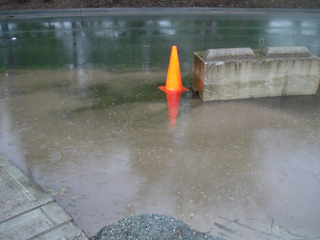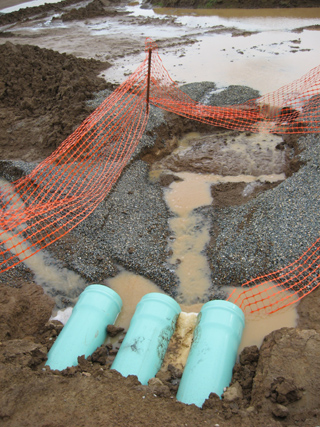
Surveys
DJC.COM
June 26, 2008
New stormwater discharge challenges loom
Special to the Journal

Ziemer
|

Hardebeck
|
We are approaching the second anniversary of the implementation of Ecology’s Phase II National Pollutant Discharge Elimination System (NPDES) Construction Stormwater Permit. The new construction permit lowered the criteria for permit coverage from five acres to one acre of exposed soil. This upcoming wet season will bring new challenges to those sites by requiring stormwater discharge monitoring of turbidity and pH.
Similarly, the Municipal NPDES Stormwater Permit is undergoing changes, where more than 90 jurisdictions in Washington are covered under phase two. This means that many cities and counties, which did not have a program before, now need to develop a program to address stormwater issues within their jurisdiction.

Photos by Nathan Hardebeck A heightened focus on stormwater issues has lead municipalities to consider how to manage pollutants, and their sources, that contribute to their conveyance systems. |
Ecology’s release of the municipal phase two permit was met with strong opposition and was challenged in court. Various groups are suing Ecology and the EPA, claiming violations of the Endangered Species Act. The crux of the argument is that the “standards” Ecology prescribed in the permit are not tough enough to meet necessary water quality requirements to protect local endangered species.
In the May edition of Stormwater magazine, Sue Joerger of Puget Soundkeepers states, “Ecology has failed to develop an effective regulatory and enforcement strategy to protect water quality and salmon when it rains.”
Her statement highlights the focus of these groups: Setting and enforcing standards that protect endangered species and water quality.
This heightened focus on stormwater has lead municipalities to seriously consider how to manage pollutants, and their sources, that contribute to their conveyance systems. They are not only faced with reducing the impact of pollutants from identifiable sources such as industrial and constructions sites, but also limiting non-point source contributions. To address compliance, many phase one and two jurisdictions are focusing their attention on industry and construction sites to reduce pollutant loading to their systems.
Some phase two municipalities are ahead of the curve in the development of their NPDES programs. Not only do they have routine maintenance of the surfaces and conveyance lines they are directly responsible for, but they have also developed programs that place emphasis on pollution control for construction and industrial sites.
Construction’s impact

Construction sites are considered to be one of the major contributors of sediment to stormwater. |
Construction sites are considered to be one of the major contributors of sediment to stormwater. The EPA states that sediment is the number one stormwater pollutant in the U.S.
Fine sediment particles, suspended in water, are very difficult to remove and often have other pollutants associated with them that contribute to an increased pollutant load to receiving waters. High turbidity in runoff can reduce dissolved oxygen, raise the temperature of the water, decrease the predation by fish, and smother eggs of sensitive species.
To make sure that construction sites within municipal jurisdictions do not cause harm to receiving waters, some cities and counties have created wet-weather plans for sites that continue construction through the rainy months. In addition, some municipalities have shut down construction during the wetter months. This has created hardships for developers and contractors in terms of completing projects prior to buttoning up for the winter, as well as carrying the potential lost revenue and paying the taxes and interest on an uncompleted site.
Other cities have implemented a performance bond system in which the contractor must pay a certain fee prior to working through the wet months. If their site stays in compliance with water quality parameters, they get a refund; if their site is in violation of established water quality standards, they lose the deposit and have to pay the deposit again to continue to work.
Finally, there are other municipalities that establish a new water quality benchmark for wet months altogether. These benchmarks may require the use of advanced treatment technologies. Those municipalities are leaving it up to the contractor or developer to decide whether shutting down the site for the winter is more economical than implementing an advanced treatment technology that can meet the new strict water quality discharge standards.
CESCL inspectors
Ecology’s requirement for a Certified Erosion and Sediment Control Lead (CESCL) to be designated for any site disturbing one acre or more is also being used by some municipalities to aid in compliance monitoring. A few jurisdictions have required that the CESCL inspector be from a third party and submit the results both to the contractor and the governing municipality.
Municipalities are also discussing the idea of deputizing their stormwater inspection force. This is already happening in British Columbia and Oregon and is sure to catch on in Washington in the near future. Inspectors will visit both construction and industrial sites with the legal authority to come on the site to investigate water quality issues. If the site is found in violation of standards, the inspector will have the ability to write a ticket on the spot, without having to go through the rigors of enforcing civil penalties under the Clean Water Act. In some cases, they may even take criminal action against egregious violators.
There are several municipalities that are very focused on maintenance. They are placing a greater emphasis on local business and property owners to maintain their sites and routinely clean their conveyance systems, so the load to the overall municipal system is reduced. Maintenance of stormwater systems does not only affect construction sites and business, but it affects every citizen in terms of taxes to develop and maintain stormwater programs.
Stormwater controls and regulations are not going to diminish. The EPA is discussing changes to the construction NPDES program. Ecology just recently required changes to WSDOT’s permit which will cause it to enhance and expand its program.
As we edge ever closer to the final decisions before the pollution controls hearing boards of the Municipal NPDES permit in Washington, be assured that when dealing with stormwater issues, you will need to do your homework. Each jurisdiction may govern their water quality issues differently and what worked for you here, may not work for you five miles down the road.
Jason Ziemer is vice president of technology and development at Worldwide Water and has spent nearly a decade working with erosion/sediment control and stormwater management on construction and industrial sites. Nathan Hardebeck is the environmental communications/marketing manager for Clear Water Compliance Services. For the past eight years Hardebeck has been involved with industrial stormwater compliance issues, policy formation, post construction BMPs and public education programs.
Other Stories:
- Corporate social responsibility turns green
- A green approach to gold mining in the Okanogan
- Financing evolves to benefit the environment
- Homeowners rethink their waterfronts
- Will Earthships save the Earth?
- Municipalities discover the benefits of eco-roofs
- What lies ahead for sustainable design?
- Planning our communities for a low-carbon future
- City, tribe team up on clean water project
- Architectural firm sets a zero-energy goal
- Green building’s future lies in innovation, conservation
- Seattle becomes a hotbed for clean technologies
- Speed up sustainable development with a planned-action EIS
- Avoiding fish-related construction delays
Copyright ©2009 Seattle Daily Journal and DJC.COM.
Comments? Questions? Contact us.